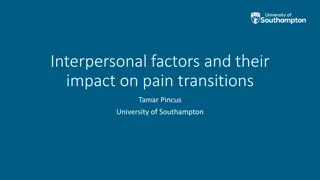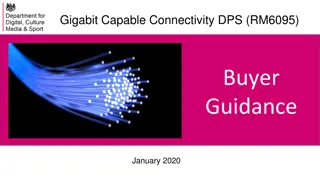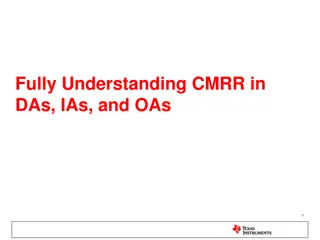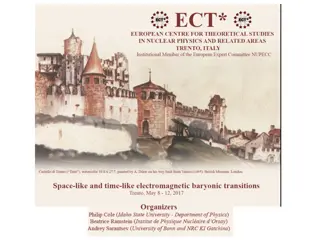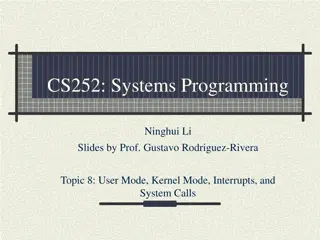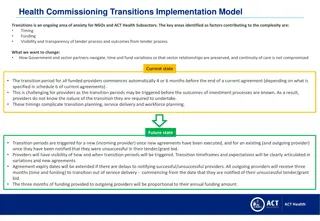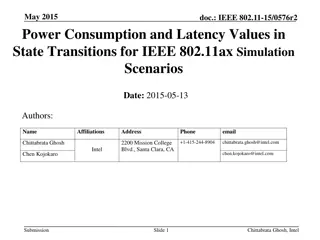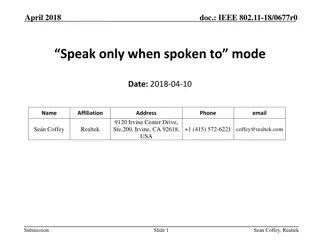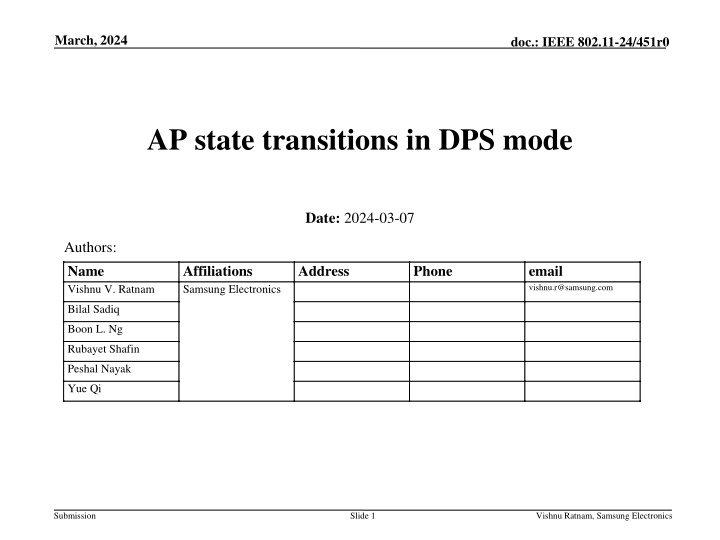
IEEE 802.11-24 Dynamic Power Save Mode for AP State Transitions
Explore the IEEE 802.11-24 document discussing Dynamic Power Save (DPS) mode for Access Points (APs) and methods for smooth power state transitions without compromising network performance. Learn about DPS operation in low and high power states, enabling DPS mode, and UHR device support for enhanced capabilities.
Download Presentation

Please find below an Image/Link to download the presentation.
The content on the website is provided AS IS for your information and personal use only. It may not be sold, licensed, or shared on other websites without obtaining consent from the author. If you encounter any issues during the download, it is possible that the publisher has removed the file from their server.
You are allowed to download the files provided on this website for personal or commercial use, subject to the condition that they are used lawfully. All files are the property of their respective owners.
The content on the website is provided AS IS for your information and personal use only. It may not be sold, licensed, or shared on other websites without obtaining consent from the author.
E N D
Presentation Transcript
March, 2024 doc.: IEEE 802.11-24/451r0 AP state transitions in DPS mode Date: 2024-03-07 Authors: Name Vishnu V. Ratnam Affiliations Samsung Electronics Address Phone email vishnu.r@samsung.com Bilal Sadiq Boon L. Ng Rubayet Shafin Peshal Nayak Yue Qi Submission Slide 1 Vishnu Ratnam, Samsung Electronics
March, 2024 doc.: IEEE 802.11-24/451r0 Abstract This document discusses our thoughts on Dynamic Power Save (DPS) operation for an AP, and proposes methods for an AP operating in DPS operation to transition between its power states without causing loss of medium synchronization. Submission Slide 2 Vishnu Ratnam, Samsung Electronics
March, 2024 doc.: IEEE 802.11-24/451r0 Introduction Existing power saving mechanisms for an AP (Operating mode change, link disablement) work at a slow time scale, are applicable equally to all STAs, and can cause a significant reduction in the network throughput. To allow an AP to save power dynamically without degrading the latency and throughput performance of UHR devices, Dynamic Power-Save (DPS) mechanism was proposed in 11- 23-10r0 [1]. Similar to EMLSR and dynamic SMPS, an AP in DPS mode operates in a low power state (low capability state) by default to save power. It transitions to a high power state (high capability state) on demand, after receiving an initial control frame (ICF) from the TXOP owner. The AP may remain in the high power state for the duration of the TXOP. For example, low power state: 80MHz and 1 NSS, and high power state: 160MHz, 4 NSS. By initiating an uplink transmission with an ICF, a UHR non-AP STA that supports DPS can reap the benefits of the full capabilities of the AP for the duration of the TXOP. Low-power state Low-power state High-power state Frequency ICF (padding) Uplink PPDUs (padding) ICF (padding) Resp. frame ACK Time DPS Transition Delay DPS Padding Delay Submission Slide 3 Vishnu Ratnam, Samsung Electronics
March, 2024 doc.: IEEE 802.11-24/451r0 DPS mode - Enablement A UHR AP indicates its capability of operating in DPS mode, and a UHR non-AP STA indicates its capability of supporting DPS operation in the UHR Capabilities element. Before enabling DPS operation, an AP shall use Operating mode change or Channel switch announcement procedure to indicate reduction in BW and/or NSS to the values corresponding to the DPS low power state. These reduced parameters are also indicated in the legacy (pre-UHR) Operation element(s) transmitted by the AP. This allows backward compatibility to legacy STAs when the AP transitions to DPS mode. To initiate DPS operation, in UHR specific fields of the beacon, probe response and association response frames, the AP may provide an indication of: Operating in DPS mode DPS parameters including DPS Padding delay, DPS Transition delay. AP capabilities in the high-power state (BW, NSS, locations of secondary channels) etc. AP Provide indication of transition to lower capabilities Provide indication of transition to DPS mode in UHR fields Reduced capability operation DPS mode baseline operation Submission Slide 4 Vishnu Ratnam, Samsung Electronics
March, 2024 doc.: IEEE 802.11-24/451r0 DPS mode UL operation A UHR STA supporting DPS mode that intends to exploit the high-power state capabilities of the AP for uplink transmission shall initiate the uplink transmission with an ICF. The frame can be sent in duplicate non-HT PPDU format, and the frame can carry sufficient padding to enable the AP to transition from low-power to high power state. A frame with sufficient padding may be provided at the end of the TXOP to enable to AP to transition back to the low-power state. Note: ICF can be skipped if non-AP STA is aware of AP s being in high power state (e.g. slide 9). Legacy (pre-UHR) STAs, UHR STAs that do not support DPS mode, and UHR STAs that do not intend to use the AP s high-power capabilities can communicate with the AP as per the AP s low power state capabilities (without using an initial control frame). High-power state Low-power state Low-power state TXOP Duration BA Frequency Resp. from AP Frame with Padding to (Padding) medium. protect SIFS SIFS BA SIFS SIFS ICF SIFS Uplink PPDUs BA Primary ACK BA Time DPS Padding Delay DPS Transition Delay Submission Slide 5 Vishnu Ratnam, Samsung Electronics
March, 2024 doc.: IEEE 802.11-24/451r0 DPS mode DL operation An AP that is in DPS mode and operating in high power state may initiate communication with UHR STAs that support DPS operation as per the AP s high power state capabilities. An AP that is in DPS mode and operating in low power state may initiate communication with UHR STAs that support DPS operation as per the AP s low power state capabilities. An AP that is in DPS mode shall initiate communication with legacy (pre-UHR) STAs and UHR STAs that do not support DPS mode as per the AP s low power state capabilities. Submission Slide 6 Vishnu Ratnam, Samsung Electronics
March, 2024 doc.: IEEE 802.11-24/451r0 AP state transitions in DPS mode Even without receiving a request by a non-AP STA in a TXOP, an AP operating in DPS mode may desire to transition between the high-power and low-power states. For example, if the AP determines it has a lot of buffered traffic to deliver or channel utilization is high, it may unilaterally decide to transition to the high power state. DPS state transitions can cause temporary blindness at the AP, which can lead to loss of medium synchronization at the AP. Thus, mechanisms to prevent loss of medium synchronization at the AP during the DPS state transitions are required. Submission Slide 7 Vishnu Ratnam, Samsung Electronics
March, 2024 doc.: IEEE 802.11-24/451r0 Protecting AP state transitions in DPS mode If AP wins a TXOP, it can transmit: a trigger frame to a DPS supporting STA, requesting the STA to provide sufficient padding in the response frame to cover the state transition. The transition can be performed during the padding field of the response frame. If AP observes a transmission for which it is neither TXOP owner nor responder, it may perform the transition during the TXOP if the TXOP has sufficient NAV duration to accommodate the state transition. There may be other restrictions on the TXOPs. E.g., TXOPs should not allow spatial reuse if they are OBSS TXOPs. High power state Low power state NAV Duration High power state Low-power state Trigger DPS with Padding Frequency Supporting Frequency Response NAV Duration Trigger SIFS STA PPDUs not addressed to AP Time Time DPS Padding Delay DPS Padding Delay Submission Slide 8 Vishnu Ratnam, Samsung Electronics
March, 2024 doc.: IEEE 802.11-24/451r0 Providing indication of AP s DPS state An AP in DPS mode may continue operating in the high-power state for an extended duration, without transitioning out of DPS mode. For example, if the AP determines that the channel utilization is too high or if there is a request from a non-AP STA. Note: This is preferred to transitioning out of DPS mode, since transitioning into DPS mode is a slow process that requires prior indication by the AP for a sufficient period of time. When operating in the high-power state for an extended duration, the AP shall broadcast in beacons an indication of its current DPS state and the duration of the state (in TBTTs). A UHR STA that supports DPS and that has received an indication of the AP operating in high power state for an extended duration can directly initiate communicate with the AP as per the AP s high power state capabilities (without using an initial control frame). Submission Slide 9 Vishnu Ratnam, Samsung Electronics
March, 2024 doc.: IEEE 802.11-24/451r0 Conclusion Channel switch announcement, Operating mode procedures etc., can be used by an AP to transition to low power state before enabling DPS mode. This allows backward compatibility to legacy STAs. UHR STAs that support DPS operation, may either: Communicate with the AP as per the low power state capabilities, or Request an AP to transition to high power state within a TXOP by initiating the TXOP with an initial control frame with sufficient padding. An AP performing DPS state transitions (without a non-AP s request within a TXOP) can suffer from blindness issue. Solutions to prevent loss of medium synchronization during the transition are presented here. AP may desire to stay in the high power state of DPS mode for an extended duration without disabling DPS mode. In this case, the AP should indicate its current DPS state and its duration in beacons, to allow UHR STAs to exploit this information. Submission Slide 10 Vishnu Ratnam, Samsung Electronics
March, 2024 doc.: IEEE 802.11-24/451r0 References 1. 11-23-0010-00-0uhr-considerations-for-enabling-ap-power-save 2. 11-23-0015-00-0uhr-ap-mld-power-management 3. 11-23-0225-00-0uhr-considering-unscheduled-ap-power-save 4. 11-23-1835-00-00bn-ap-power-management 5. 11-23-1936-00-00bn-ap-mld-power-save-follow-up 6. 11-23-1965-02-00bn-dynamic-power-save-follow-up Submission Slide 11 Vishnu Ratnam, Samsung Electronics
March, 2024 doc.: IEEE 802.11-24/451r0 Backup slides Submission Slide 12 Vishnu Ratnam, Samsung Electronics

